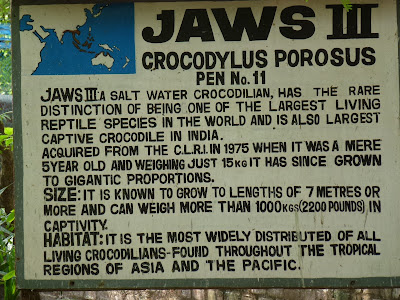 |
| Henrietta, Lakhdeep, Milan, Kieran and Isabelle |
|
We’ve been home for a week now and yet I still keep stopping
myself from running tap water on my toothbrush. I look around, notice
that there is no water bottle next to the sink, and smile at the convenience
of having safe water at the turn of a knob! Resuming our lives, we've
been to work, school, the grocer's and the pet shop... jet lag is no longer a
viable excuse for procrastination.
Our next stop in Tamil Nadu was the Madras Crocodile Bank
Trust. Our dear friend Bruce Schwedick
was kind enough to put us in contact with the Trust’s current director, Colin
Stevenson. Colin was extremely generous
with his time and we spent the morning following him around the facility and
learning more about crocodile conservation in India.
A little history: In
the 1970s, after nearly 100 years of hunting crocodilians for fashion
accessories, India’s
three indigenous crocs were on the brink of extinction. The three species of Indian crocodilians are
the mugger (Crocodylus palustris), the saltwater crocodile (Crocodylus porosus)
and the gharial (Gavialis gangeticas), with current wild population estimates
at less than 250. The Trust was
established in 1976 by Romulus
and Zai Whittaker. One of their adult
sons (Nikhil) currently acts as curator of the Trust. For those of you interested in more
information, please go to:
http://www.madrascrocodilebank.org/cms/.
The facility has an impressive and
interesting history.
Upon arriving at the facility, we were escorted through the
keeper area to a small office building and introduced to Colin. He is a native of Australia, and part of me was
expecting the caricature likes of Steve Irwin/Crocodile Dundee, but instead we
saw a quiet, studious-looking man who, if he ever uses the word “Crikey!”, I am
sure he saves it for very special occasions.
The Madras Crocodile Bank Trust currently houses 18 of the world's 23 crocodile species. It is a research and breeding facility, but also acts as a working zoo and hosts about half a million visitors each year. The layout of the zoo is charming. Sandy paths weave through green pools with walls built of local stone and brick. Mature trees offer natural shade throughout the facility. Enjoy!
 |
| Mugger on the move |
 |
| The signage was adorable! |
|
|
 |
| Tomistoma |
 |
| Enclosure example. Colin said the iron fences were just added a few years ago. |
|
|
 |
| Tail scales |
 |
| Surprisingly few missing limbs for such a high density mugger exhibit! |
 |
| Morelet's Crocodile |
|
 |
| Camera Two, kids! Camera Two!! |
 |
| Gharial |
 |
| Jaws III |
 |
| Colin giving us a tour. |
 |
| As kids, my siblings and I used to pile onto my parents' bed on Saturday mornings. We would always say we were like the alligators at the zoo. This pile of muggers reminded me of those cold Midwestern Saturdays. |
 |
| Dangerous animals! |
 |
| Why do Tomistoma remind me of dolphins?? |
|
|
|
The "dangerous animals" in our group were picked off by a strange new species... one by one.
 |
| Milan, the oldest, went first. |
 |
| Isabelle wasn't going down without a fight (or a scream). |
 |
| Kieran... keeping it cool. |
 |
| This kingfisher was visiting the Trust the same day as us! |
 |
| The underwater viewing area for the Gharial exhibit. |





















No comments:
Post a Comment